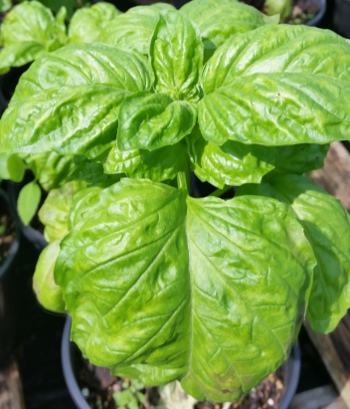Growing Lettuce Leaf Basil in Northeast Florida Herb Gardens
(Ocimum basilicum ‘lettuce leaf’)
Lettuce Leaf Basil Herb Plants For Northeast Florida Origins:

Basil plants originate in tropical areas of Asia, Australia, and Africa. There are currently 35 species of basil with lots of cultivars being developed within those species. All basil is prized for its highly aromatic foliage and most have a spicy scent and taste.
Lettuce Leaf Basil is an heirloom variety that has been grown and cultivated for its giant leaves and mild, sweet flavor. Lettuce Leaf Basil plants are densely foliated and grow vigorously.
Growing Season for Northeast Florida Lettuce Leaf Basil Herb Plants:
A warm season annual that is very cold sensitive, damaged by temperatures as warm as 50 degrees. That puts these plants on the late spring and summer growing list even here in our subtropical Northeast Florida climate.
Sun Exposure for Lettuce Leaf Basil Herb Plants in Northeast Florida:
Plant Lettuce Leaf Basil in areas where it will receive morning sun and afternoon shade for best results in Jacksonville and St. Augustine area gardens. Full sun locations can be a bit overpowering on these soft annual plants during the heat of the summer. Filtered light under taller canopy trees will work nicely as well. ( Rule of thumb: if grass will grow in your amount of shade, then so will basil plants. Heavy shade that would cause grass to thin out or die isn’t recommended.)
When planting basil on a porch, patio, or as an indoor house plant, place them in a location that receive at least 4-6 hours of light each day.
Soil Preference for Lettuce Leaf Basil Herb Plants:
Moist, but well draining soils. Root rot will be problematic in continuously water logged soils.
When planting basil into the ground, amend the soil generously with compost. It acts as a sponge and helps to keep the soil moist and well drained. Basil planted into the ground during the summer months will suffer root rot during the rainy season if the soil is not well drained. (Planting under root thirsty trees will alleviate this problem, but you will have to remember to water well when it’s not raining, just as you would with potted herbs).
Amend your planting site generously with compost when installing your new basil plants.
Basil also makes a great container plant as well, as the plant and root system take up very little room. For best results, allow the larger selections of basil an 8-12 inch wide space in your container to grow. You may, however, want to consider adding a soil moisture retention granule like Soil Moist® to your potting soil mix to help conserve water.
Water and Fertilizer Requirements of Lettuce Leaf Basil Herb Plants:
Newly planted seeds will require watering every day until the set of mature leaves emerges, then taper back watering to three times a week, then twice a week for in-ground plants and three to four times a week for potted containers.
In General, herbs need little fertilizer. To much fertilizer can lead to lush green growth with low volitale oils in the plant, less oils equals less flavor and aroma for your herbs. However, when planting into Florida`s sandy soils you may find your plants in need of a boost. If so, try fertilizing with a mixture of organic fish emulsions and seaweed at one ounce of each per gallon of water. Put into a sprayer and water every other week or as needed with the mixed solution. If your leaves still look a bit lackluster consider a bit of blood meal fertilizer.
Or, if you find your plant struggling at any point, make up a batch of compost tea and water generously. Repeat as needed weekly or biweekly.
Size of Lettuce Leaf Herb Plants:
The mature size on a Lettuce Leaf Basil plant will be just 12-24 inches tall and just about 10 inches wide!
Sowing Lettuce Leaf Basil Herb Seeds into Northeast Florida Soils:
Lettuce Leaf Basil seeds germinate easily and can be directly sown right into their final destination in the garden or planted into pots indoors during late winter and transplanted into the garden after all danger of frost has passed.
Harvesting Lettuce Leaf Basil Herb Plants in the Northeast Florida Landscape:
Basil needs to be pinched frequently in order to make them branch out and fill in. Harvesting should be done throughout the growing season.
Harvesting your basil often keeps it growing and producing those prized leaves. Simply pinch or cut the stem tips anywhere they are still green. Pruning or pinching past the soft green stems and into the hardened off, or brown stems, will cause growth to cease. I recommend removing the top 1/3 of the growth when harvesting.
If you have allowed your basil to form flowers, then prune as soon as possible to remove all flower stalks, so that the plant keeps putting it’s energy into putting out new leaves, not forming seeds. Allow seed heads to form at the end of the season for next year’s basil crop.
Blooms and Seeds of Basil Herbs for Northeast Florida Landscape:
Basil flowers may seem attractive, in fact the delicate upright flower bracts really are quite showy, but allowing them to form will only lead to seed production, and before you are done harvesting your basil leaves for the season, that will stop your basil’s growth in its tracks! Remove the top 1/3 of the plants growth when flowers form.
Seeds of Lettuce leaf basil herb plants can be sown directly into the garden or planted indoors and transplanted into the garden once all danger of frost has past. Remember Basil can be damaged by temperatures as low as 50 degrees!


